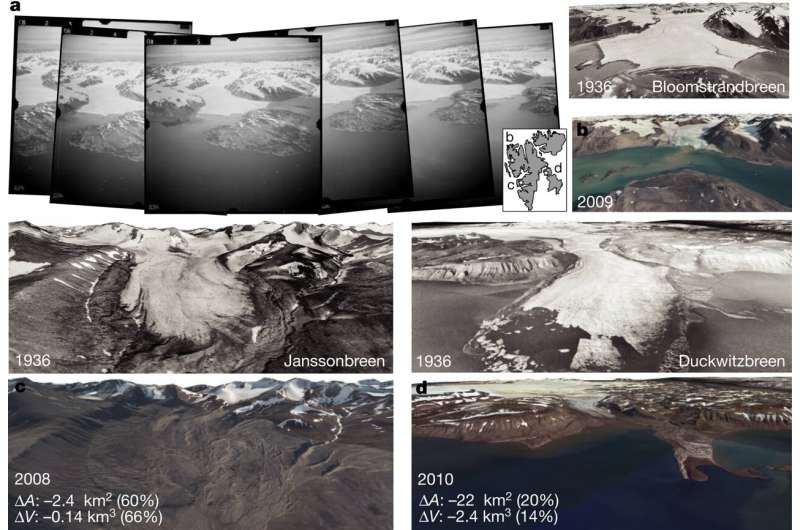January 20, 2022 report
Historical study of Norwegian archipelago Svalbard shows rate of melting glaciers speeding up

A team of researchers from the Norwegian Polar Institute, Uppsala University, Princeton University and California Institute of Technology reports that the rate of glacial melt in a Norwegian archipelago, Svalbard, is speeding up as global warming continues unabated. In their paper published in the journal Nature, the group describes a unique method of measuring glacial melting that produced an estimate of the rate of melting in the future. Twila Moon with the University of Colorado has published a News & Views piece in the same journal issue outlining the work done by the researchers.
Prior research has shown that global warming is resulting in glacial melting, which in turn is leading to rising ocean levels. Prior research has also shown that temperatures in some of the colder parts of the planet, such as the Arctic, are rising faster than elsewhere. In this new effort, the researchers sought to learn more about the pace of glacial melting in the Norwegian archipelago Svalbard.
The team began by noting that data from satellites only goes back a few decades. To gain a better perspective on warming in the region and the pace of glacial melt, they used a technique that has been used for other long-timescale projects. Called space-for-time substitution, the method involves taking advantage of geological features, such as the very large number of glaciers in the region. To learn more about glacial melting, they studied development patterns of hundreds of glaciers over relatively short periods of time rather than a single glacier over a very long period of time.
The method is useful because the glaciers exist in a very wide variety of climates. By studying photographs taken during the late 1930s, comparing them and then averaging the results, they were able to calculate the rate at which the region has been warming, along with the rate of melting and increases in melting rates. They found that the region has been warming at a rate of 1.7 degrees Celsius per decade since 1991. They then used that data to make multiple predictions about the rate of increase in glacial melting for the region, depending on whether or not global warming is brought under control. They found that under modest conditions, the rate of glacial melting will increase by 1.9 times by 2100, totaling 0.67 meters per year. Under the worst-case scenario, the rate will rise to 0.92 meters per year.
More information: Emily C. Geyman et al, Historical glacier change on Svalbard predicts doubling of mass loss by 2100, Nature (2022). DOI: 10.1038/s41586-021-04314-4
Twila A. Moon, Future ice loss captured by historical snapshots, Nature (2022). DOI: 10.1038/d41586-022-00046-1
Journal information: Nature
© 2022 Science X Network



















